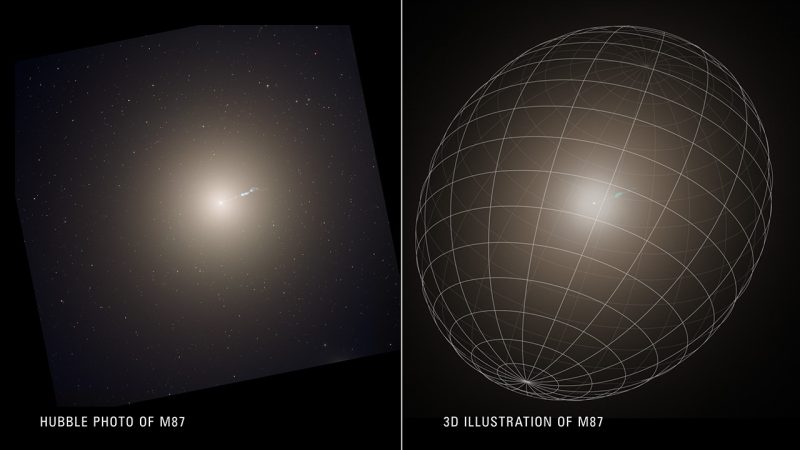This new 3D map of giant galaxy M87 shows it has a potato shape.
New 3D map of giant galaxy
The giant elliptical galaxy M87 has been the focus of many astronomical studies. In fact, its central black hole was the first scientists ever imaged. And the prominent jet emanating from the black hole has been the subject of much study, too. On April 13, 2023, NASA announced that researchers have now made a 3D map of the stars in the galaxy, and it turns out it’s rather potato-shaped.
A team of scientists from UC Berkeley and Texas A&M University published their study on the 3D shape of M87 in the peer-reviewed The Astrophysical Journal Letters on March 15, 2023.
Discovering the potato shape
The scientists used the Hubble Space Telescope and the Keck Observatory in Hawaii to study M87. M87 is a giant elliptical galaxy that formed from the collision of other galaxies. It’s 10 times the size of our Milky Way galaxy.
To find the 3D shape of the galactic blob that looks two-dimensional from our limited viewpoint on Earth, the scientists plotted the motions of the galaxy’s stars. They mapped the spectra of stars in an area 70,000 light-years across, including the region around the central black hole. Even though the researchers couldn’t see individual stars from its distance of 53 million light-years, they could still detect their motion. As Chung-Pei Ma of UC Berkeley explained:
It’s sort of like looking at a swarm of 100 billion bees. Though we are looking at them from a distance and can’t discern individual bees, we are getting very detailed information about their collective velocities.
Looking at the stellar motion, the scientists were able to build a 3D view of the galaxy and found it to be potato-shaped, or triaxial.

A better estimate of the central black hole
Learning the true shape of M87 is helping researchers understand its central black hole better. For instance, they were able to make a much more precise measurement of the black hole, determining it has 5.4 billion times the mass of our sun. Ma said:
Knowing the 3D shape of the ‘swarming bees’ enabled us to obtain a more robust dynamical measurement of the mass of the central black hole that is governing the bees’ orbiting velocities.
They’re also gaining insight on the black hole’s spin rate. Ma explained:
Now that we know the direction of the net rotation of stars in M87 and have an updated mass of the black hole, we can combine this information with data from the Event Horizon Telescope to constrain the spin.
When Edwin Hubble first classified galaxies according to their shapes in the 1920s, he labeled the blobby-looking galaxies as elliptical. Now, a century later, scientists have shared the first 3D map of an elliptical galaxy.
Bottom line: Scientists analyzed the motion of stars to make a new 3D map of giant galaxy M87. This map shows that the huge elliptical galaxy has a potato shape.











